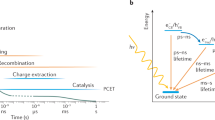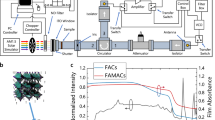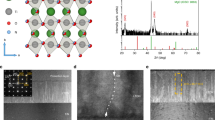Abstract
Light absorption in strongly correlated electron materials can excite electrons and holes into a variety of different states. Some of these excitations yield mobile charge carriers, whereas others result in localized states that cannot contribute to photocurrent. The photogeneration yield spectrum, ξ(λ), represents the wavelength-dependent ratio between the contributing absorption that ultimately generates mobile charge carriers and the overall absorption. Despite being a vital material property, it is not trivial to characterize. Here, we present an empirical method to extract ξ(λ) through optical and external quantum efficiency measurements of ultrathin films. We applied this method to haematite photoanodes for water photo-oxidation, and observed that it is self-consistent for different illumination conditions and applied potentials. We found agreement between the extracted ξ(λ) spectrum and the photoconductivity spectrum measured by time-resolved microwave conductivity. These measurements revealed that mobile charge carrier generation increases with increasing energy across haematite’s absorption spectrum. Low-energy non-contributing absorption fundamentally limits the photoconversion efficiency of haematite photoanodes and provides an upper limit to the achievable photocurrent that is substantially lower than that predicted based solely on absorption above the bandgap. We extended our analysis to TiO2 and BiVO4 photoanodes, demonstrating the broader utility of the method for determining ξ(λ).
This is a preview of subscription content, access via your institution
Access options
Access Nature and 54 other Nature Portfolio journals
Get Nature+, our best-value online-access subscription
$29.99 / 30 days
cancel any time
Subscribe to this journal
Receive 12 print issues and online access
$259.00 per year
only $21.58 per issue
Buy this article
- Purchase on Springer Link
- Instant access to full article PDF
Prices may be subject to local taxes which are calculated during checkout




Similar content being viewed by others
Data availability
The authors declare that the data supporting the findings of this study are available within the paper and its Supplementary Information files.
Change history
09 September 2021
A Correction to this paper has been published: https://doi.org/10.1038/s41563-021-01116-x
References
Green, M. A. Photovoltaic principles. Physica E 14, 11–17 (2002).
Liao, P. & Carter, E. A. Optical excitations in hematite (α-Fe2O3) via embedded cluster models: a CASPT2 study. J. Phys. Chem. C 115, 20795–20805 (2011).
Hayes, D. et al. Electronic and nuclear contributions to time-resolved optical and X-ray absorption spectra of hematite and insights into photoelectrochemical performance. Energy Environ. Sci. 9, 3754–3769 (2016).
Najafov, H., Biaggio, I., Podzorov, V., Calhoun, M. F. & Gershenson, M. E. Primary photoexcitations and the origin of the photocurrent in rubrene single crystals. Phys. Rev. Lett. 96, 056604 (2006).
Bakulin, A. A. et al. The role of driving energy and delocalized states for charge separation in organic semiconductors. Science 335, 1340–1344 (2012).
Sinkkonen, J., Ruokolainen, J., Uotila, P. & Hovinen, A. Spatial collection efficiency of a solar cell. Appl. Phys. Lett. 66, 206–208 (1995).
Segev, G. et al. The spatial collection efficiency of charge carriers in photovoltaic and photoelectrochemical cells. Joule 2, 210–224 (2018).
Sivula, K., Le Formal, F. & Grätzel, M. Solar water splitting: progress using hematite (α-Fe2O3) photoelectrodes. ChemSusChem 4, 432–449 (2011).
Kay, A. et al. Effect of doping and excitation wavelength on charge carrier dynamics in hematite by time-resolved microwave and terahertz photoconductivity. Adv. Funct. Mater. 30, 1901590 (2020).
Hartman, J. S. & Lind, M. A. Spectral response measurements for solar cells. Sol. Cells 7, 147–157 (1982).
Chen, Z., Dinh, H. N. & Miller, E. in Photoelectrochemical Water Splitting: Standards, Experimental Methods, and Protocols 87–97 (Springer, 2013); https://doi.org/10.1007/978-1-4614-8298-7_7
Kennedy, J. H. & Frese, K. W. Photooxidation of water at Fe2O3 electrodes. J. Electrochem. Soc. 125, 709–714 (1978).
Kay, A. et al. Wavelength dependent photocurrent of hematite photoanodes: reassessing the hole collection length. J. Phys. Chem. C 121, 28287–28292 (2017).
Kim, D. W. et al. Greenlighting photoelectrochemical oxidation of water by iron oxide. ACS Nano 8, 12199–12207 (2014).
Su, Z., Baskin, J. S., Zhou, W., Thomas, J. M. & Zewail, A. H. Ultrafast elemental and oxidation-state mapping of hematite by 4D electron microscopy. J. Am. Chem. Soc. 139, 4916–4922 (2017).
Braun, A. et al. Direct observation of two electron holes in a hematite photoanode during photoelectrochemical water splitting. J. Phys. Chem. C 116, 16870–16875 (2012).
Carneiro, L. M. et al. Excitation-wavelength-dependent small polaron trapping of photoexcited carriers in α-Fe2O3. Nat. Mater. 16, 819–825 (2017).
Dotan, H. et al. Resonant light trapping in ultrathin films for water splitting. Nat. Mater. 12, 158–164 (2013).
Hutter, E. M. et al. Direct–indirect character of the bandgap in methylammonium lead iodide perovskite. Nat. Mater. 16, 115–120 (2017).
Piekner, Y. et al. Implementing strong interference in ultrathin film top absorbers for tandem solar cells. ACS Photon. 5, 5068–5078 (2018).
Jellison, G. E. Data analysis for spectroscopic ellipsometry. Thin Solid Films 234, 416–422 (1993).
Sinkkonen, J., Hovinen, A., Siirtola, T., Tuominen, E. & Acerbis, M. Interpretation of the spectral response of a solar cell in terms of the spatial collection efficiency. In Conference Record of the IEEE Photovoltaic Specialists Conference 561–564 (IEEE, 1996); https://doi.org/10.1109/pvsc.1996.564068
Donolato, C. Reconstruction of the charge collection probability in a solar cell from internal quantum efficiency measurements. J. Appl. Phys. 89, 5687–5695 (2001).
Segev, G. et al. Quantification of the loss mechanisms in emerging water splitting photoanodes through empirical extraction of the spatial charge collection efficiency. Energy Environ. Sci. 11, 904–913 (2018).
Ouellette, O. et al. Spatial collection in colloidal quantum dot solar cells. Adv. Funct. Mater. 1908200 (2020).
Burkhard, G. F., Hoke, E. T. & McGehee, M. D. Accounting for interference, scattering, and electrode absorption to make accurate internal quantum efficiency measurements in organic and other thin solar cells. Adv. Mater. 22, 3293–3297 (2010).
Fondell, M., Jacobsson, T. J., Boman, M. & Edvinsson, T. Optical quantum confinement in low dimensional hematite. J. Mater. Chem. A 2, 3352–3363 (2014).
Chernyshova, I. V. et al. On the origin of an unusual dependence of (bio)chemical reactivity of ferric hydroxides on nanoparticle size. Phys. Chem. Chem. Phys. 12, 14045–14056 (2010).
Lin, Y., Zhou, S., Sheehan, S. W. & Wang, D. Nanonet-based hematite heteronanostructures for efficient solar water splitting. J. Am. Chem. Soc. 133, 2398–2401 (2011).
Riha, S. C., Devries Vermeer, M. J., Pellin, M. J., Hupp, J. T. & Martinson, A. B. F. Hematite-based photo-oxidation of water using transparent distributed current collectors. ACS Appl. Mater. Interfaces 5, 360–367 (2013).
Barroso, M., Pendlebury, S. R., Cowan, A. J. & Durrant, J. R. Charge carrier trapping, recombination and transfer in hematite (α-Fe2O3) water splitting photoanodes. Chem. Sci. 4, 2724–2734 (2013).
Savenije, T. J., Ferguson, A. J., Kopidakis, N. & Rumbles, G. Revealing the dynamics of charge carriers in polymer:fullerene blends using photoinduced time-resolved microwave conductivity. J. Phys. Chem. C 117, 24085–24103 (2013).
Kunst, M. & Beck, G. The study of charge carrier kinetics in semiconductors by microwave conductivity measurements. J. Appl. Phys. 60, 3558–3566 (1986).
Quist, P. A. C. et al. Photogeneration and decay of charge carriers in hybrid bulk heterojunctions of ZnO nanoparticles and conjugated polymers. J. Phys. Chem. B 110, 10315–10321 (2006).
Ferguson, A. J. et al. Trap-limited carrier recombination in single-walled carbon nanotube heterojunctions with fullerene acceptor layers. Phys. Rev. B 91, 245311 (2015).
Pastor, E. et al. In situ observation of picosecond polaron self-localisation in α-Fe2O3 photoelectrochemical cells. Nat. Commun. 10, 3962 (2019).
Peerakiatkhajohn, P. et al.Stable hematite nanosheet photoanodes for enhanced photoelectrochemical water splitting. Adv. Mater. 28, 6405–6410 (2016).
Umebayashi, T., Yamaki, T., Itoh, H. & Asai, K. Band gap narrowing of titanium dioxide by sulfur doping. Appl. Phys. Lett. 81, 454–456 (2002).
Fujishima, A. & Honda, K. Electrochemical photolysis of water at a semiconductor electrode. Nature 238, 37–38 (1972).
Walsh, A., Yan, Y., Huda, M. N., Al-Jassim, M. M. & Wei, S. H. Band edge electronic structure of BiVO4: elucidating the role of the Bi s and V d orbitals. Chem. Mater. 21, 547–551 (2009).
Ziwritsch, M. et al. Direct time-resolved observation of carrier trapping and polaron conductivity in BiVO4. ACS Energy Lett. 1, 888–894 (2016).
Elmaslmane, A. R., Watkins, M. B. & McKenna, K. P. First-principles modeling of polaron formation in TiO2 polymorphs. J. Chem. Theory Comput. 14, 3740–3751 (2018).
Kavan, L., Grätzel, M., Gilbert, S. E., Klemenz, C. & Scheel, H. J. Electrochemical and photoelectrochemical investigation of single-crystal anatase. J. Am. Chem. Soc. 118, 6716–6723 (1996).
Abdi, F. F., Firet, N. & van de Krol, R. Efficient BiVO4 thin film photoanodes modified with cobalt phosphate catalyst and W-doping. 5, 490–496 (2013).
Trześniewski, B. J. et al. Near-complete suppression of surface losses and total internal quantum efficiency in BiVO4 photoanodes. Energy Environ. Sci. 10, 1517–1529 (2017).
Cooper, J. K. et al. Electronic structure of monoclinic BiVO4. Chem. Mater. 26, 5365–5373 (2014).
Kay, A., Cesar, I. & Grätzel, M. New benchmark for water photooxidation by nanostructured alpha-Fe2O3 films. J. Am. Chem. Soc. 128, 15714–15721 (2006).
Kölbach, M., Harbauer, K., Ellmer, K. & van de Krol, R. Elucidating the pulsed laser deposition process of BiVO4 photoelectrodes for solar water splitting. J. Phys. Chem. C 124, 4438–4447 (2020).
Grave, D. A. et al. Heteroepitaxial hematite photoanodes as a model system for solar water splitting. J. Mater. Chem. A 4, 3052–3060 (2016).
Lamers, M. et al. Enhanced carrier transport and bandgap reduction in sulfur-modified BiVO4 photoanodes. Chem. Mater. 30, 8630–8638 (2018).
Acknowledgements
D.S.E., D.A.G. and Y.P. acknowledge G. Ankonina for generously assisting on technical matters whenever needed in the Technion’s Photovoltaics Laboratory, and also A. Inbar for assisting in the EQE measurements in this work. We thank G. Atiya for the TEM measurements, L. Popilevsky from the FIB Lab at the Technion’s Russell Berrie Nanotechnology Institute (RBNI) for preparing the TEM sample, and J. N. Hilfiker from J. A. Woollam Co. for helpful correspondence regarding ellipsometry analysis. The research leading to these results received funding from the PAT Center of Research Excellence supported by the Israel Science Foundation (grant no. 1867/17). The EQE and optical measurements were carried out at the Technion’s Photovoltaics Laboratory (HTRL), supported by the RBNI, the Nancy and Stephen Grand Technion Energy Program (GTEP) and the Adelis Foundation. Part of this research was carried out within the Helmholtz International Research School ‘Hybrid Integrated Systems for Conversion of Solar Energy’ (HI-SCORE), an initiative co-funded by the Initiative and Networking Fund of the Helmholtz Association. Part of the work was funded by the Volkswagen Foundation. D.A.G. acknowledges support from the Center for Absorption in Science of the Ministry of Aliyah and Immigrant Absorption in Israel. Y.P. acknowledges support by GTEP and for a Levi Eshkol scholarship from the Ministry of Science and Technology of Israel. A.R. acknowledges the support of the L. Shirley Tark Chair in Science.
Author information
Authors and Affiliations
Contributions
D.A.G. and H.D. conceived the idea and initiated the research. D.A.G., D.S.E. and Y.P. developed the methodology for the ultrathin-film spatial collection efficiency analysis. D.A.G., Y.P. and P.S. fabricated the haematite, BiVO4 and TiO2 photoanodes. Y.P. performed the ellipsometry analysis. D.S.E. designed the EQE experiment. M.K., D.F., F.F.A. and D.A.G. designed the TRMC experiments with the help of R.v.d.K., D.A.G., D.S.E., Y.P., M.K., D.F. and A.K. performed the characterizations and data analysis. D.A.G. and D.S.E. wrote the first draft of the manuscript. A.R. supervised the project. All authors contributed to the scientific discussion and editing of the manuscript.
Corresponding authors
Ethics declarations
Competing interests
The authors declare no competing interests.
Additional information
Peer review information Nature Materials thanks Victor Batista and the other, anonymous, reviewer(s) for their contribution to the peer review of this work.
Publisher’s note Springer Nature remains neutral with regard to jurisdictional claims in published maps and institutional affiliations.
Supplementary information
Supplementary Information
Supplementary Discussion and Figs. 1–14.
Rights and permissions
About this article
Cite this article
Grave, D.A., Ellis, D.S., Piekner, Y. et al. Extraction of mobile charge carrier photogeneration yield spectrum of ultrathin-film metal oxide photoanodes for solar water splitting. Nat. Mater. 20, 833–840 (2021). https://doi.org/10.1038/s41563-021-00955-y
Received:
Accepted:
Published:
Issue Date:
DOI: https://doi.org/10.1038/s41563-021-00955-y
This article is cited by
-
Electrolyte-assisted polarization leading to enhanced charge separation and solar-to-hydrogen conversion efficiency of seawater splitting
Nature Catalysis (2024)
-
Surface photovoltage microscopy for mapping charge separation on photocatalyst particles
Nature Protocols (2024)
-
Stacking textured films on lattice-mismatched transparent conducting oxides via matched Voronoi cell of oxygen sublattice
Nature Materials (2024)
-
Hole utilization in solar hydrogen production
Nature Reviews Chemistry (2022)
-
Electronic defects in metal oxide photocatalysts
Nature Reviews Materials (2022)



